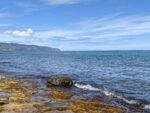
In 1959, Hawaii became the 50th state in the United States of America. Larger than Connecticut, Delaware, and Rhode Island, it is 47th in size among the 50 states. With a population of about of 1,400,000 (in 2012) Hawaii is ranked 40th in population. Located in the middle of the Pacific Ocean, 2,390 miles from California; 3,850 miles from Japan; 4,900 miles from China; and 5,280 miles from the Philippines; Hawaii is the most isolated population center on the face of the earth.
With 137 recognized islands, the state of Hawaii extends some 1,500 miles (2,400 kilometers) and has 750 miles (1,210 km) of coastline, making it the fourth-longest ocean coastline in America(after Alaska, Florida, and California). It is made up of an archipelago of eight major islands, several atolls, numerous smaller islets, and undersea sea mounts. The most known are the major eight islands which are (from East to West): Hawaii (the Big Island), Maui, Kahoolawe, Molokai, Lanai, Oahu, Kauai, Niihau. Niihau, which is privately owned, and Kahoolawe, which is uninhabited and scattered with unexploded ordinances left by the U.S. Navy, are not open to tourism and there are no major commercial flights to these islands.
With an average temperature at sea level being 85°F (29°C), the temperature in Hawaii is very consistent throughout the year. Average humidity is around 70% and with constant trade winds bringing a cool breeze through the islands, it is a very comfortable place to live. These trade winds come from the northeast and collide with the mountains, creating clouds which produce rain. Most of the rain falls on the northeastern (windward) side of the islands, creating the rich forests and splendid waterfalls. Due to this weather pattern, beautiful rainbows are often seen cast over the mountains and valleys, lending the nickname Rainbow State.




